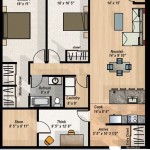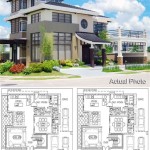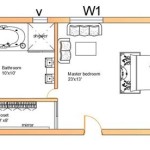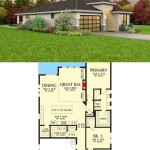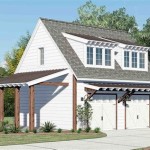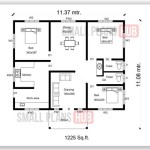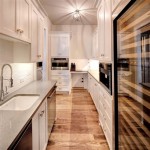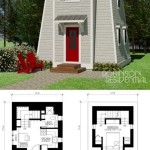Understanding Back-To-Front Sloping Lot House Plans
Sloping lots, while sometimes presenting design challenges, can be the foundation for unique and visually striking homes. Among the various approaches to building on such terrain, the back-to-front sloping lot house plan has emerged as a popular and practical solution. This design strategy capitalizes on the natural grade of the land, using it to create a multi-level dwelling where the main entrance is typically located on the higher elevation at the rear of the property, and the lower levels are exposed towards the front.
This architectural choice offers several advantages, including enhanced views, improved natural light penetration, and opportunities for walk-out basements or lower-level living spaces that seamlessly integrate with the outdoor environment. However, realizing the full potential of a back-to-front sloping lot house plan requires careful consideration of site conditions, design principles, and construction techniques. Understanding these aspects is crucial for homeowners and builders alike to ensure a successful and aesthetically pleasing outcome.
The appeal of this design lies in its ability to transform what might seem like a disadvantage – a sloping lot – into a valuable asset. By carefully planning the layout and integrating the home with the surrounding landscape, a back-to-front sloping lot house can become a testament to innovative architectural design and efficient land use.
Maximizing Views and Natural Light
One of the primary benefits of a back-to-front sloping lot house plan is the opportunity to maximize views and natural light. By positioning the rear of the house at the highest point of the lot, the design allows for expansive views from the main living areas, typically located on the upper levels. This strategic placement ensures unobstructed sightlines, enhancing the overall living experience and creating a strong connection with the surrounding environment.
Furthermore, the slope of the land facilitates the integration of large windows and glazed doors on the lower levels, which are exposed to the front of the property. This allows ample natural light to flood these spaces, reducing the need for artificial lighting and creating a bright and inviting atmosphere. The careful orientation of the house in relation to the sun's path can also optimize solar gain, contributing to energy efficiency and reducing heating costs.
The design can also incorporate features such as decks, balconies, and patios that extend from the upper levels, providing outdoor living spaces that further enhance the enjoyment of the views. These outdoor areas become extensions of the interior living spaces, blurring the boundaries between indoors and outdoors and creating a seamless flow between the two.
The strategic use of landscaping can also play a crucial role in maximizing the views and natural light. By carefully selecting and positioning trees, shrubs, and other plants, the homeowner can frame the views, create privacy, and enhance the overall aesthetic appeal of the property. Landscaping can also be used to direct sunlight into the house, further optimizing natural light penetration.
Creating Functional and Accessible Living Spaces
Back-to-front sloping lot house plans offer unique opportunities for creating functional and accessible living spaces. The natural grade of the land allows for the creation of multi-level homes with distinct zones for living, sleeping, and recreation. This separation of spaces can enhance privacy and create a more comfortable and organized living environment.
The lower levels of these homes often lend themselves well to walk-out basements or lower-level living spaces that seamlessly connect with the outdoor environment. These spaces can be used for a variety of purposes, such as entertainment areas, home offices, guest suites, or recreation rooms. The walk-out feature allows for easy access to the backyard or garden, creating a strong connection between the interior and exterior spaces.
Accessibility is another key consideration in the design of back-to-front sloping lot house plans. By carefully planning the layout and incorporating features such as ramps, elevators, and level entryways, the home can be made accessible to people of all ages and abilities. This is particularly important for homeowners who are planning to age in place or who have family members with mobility challenges.
The placement of the garage is also a crucial factor in creating functional and accessible living spaces. In many back-to-front sloping lot house plans, the garage is located at the rear of the property, providing direct access to the main living areas on the upper levels. This arrangement can simplify grocery shopping, improve security, and provide shelter from the elements.
The internal layout of the house should also be carefully considered to ensure that all spaces are functional and accessible. The use of open floor plans can create a sense of spaciousness and improve circulation, while strategically placed hallways and doorways can provide privacy and separation between different zones of the house.
Addressing Site-Specific Challenges and Considerations
While back-to-front sloping lot house plans offer numerous advantages, they also present certain site-specific challenges that must be addressed during the design and construction process. These challenges can include soil stability, drainage, erosion control, and access to utilities.
Soil stability is a critical concern, particularly on steep slopes. A thorough geotechnical investigation should be conducted to assess the soil's bearing capacity and stability. This investigation will help determine the appropriate foundation design and any necessary soil stabilization measures, such as retaining walls or soil reinforcement.
Drainage and erosion control are also essential considerations. Proper drainage systems must be designed to effectively manage stormwater runoff and prevent erosion. This may involve the installation of swales, French drains, and other drainage structures. Erosion control measures, such as silt fences and vegetation, should be implemented during construction to minimize soil loss.
Access to utilities can also be challenging on sloping lots. The design must account for the location of existing utility lines and plan for the installation of new lines. This may involve trenching, boring, or other specialized techniques. The location of the septic system, if applicable, must also be carefully considered to ensure proper drainage and compliance with local regulations.
The orientation of the house on the lot is another important factor to consider. The house should be oriented to maximize solar gain in the winter and minimize heat gain in the summer. This can be achieved by carefully positioning the house in relation to the sun's path and using appropriate shading devices, such as overhangs and trees.
Building codes and zoning regulations must also be carefully considered during the design process. These regulations may impose restrictions on building height, setbacks, and other aspects of the design. It is important to work with a qualified architect or builder who is familiar with local regulations to ensure that the design complies with all applicable requirements.
Finally, the cost of construction should be carefully considered. Building on a sloping lot can be more expensive than building on a flat lot due to the need for specialized foundation systems, excavation, and landscaping. It is important to obtain accurate cost estimates from multiple contractors before starting construction to ensure that the project stays within budget.
In summary, back-to-front sloping lot house plans offer a unique and innovative approach to building on challenging terrain. By carefully considering the site conditions, design principles, and construction techniques, homeowners and builders can create beautiful, functional, and sustainable homes that capitalize on the natural advantages of a sloping lot.

A Guide To Sloping Lot House Plans

Hillside And Sloped Lot House Plans

House Plans For A Sloped Lot Dfd Blog

Walkout Basement House Plans To Maximize A Sloping Lot Houseplans Blog Com

Hillside And Sloped Lot House Plans

Plan 68849vr Mountain Ranch For A Sloping Lot With Decks And Porches Front Back 1485 Sq Ft

Plan 64452sc House For A Rear Sloping Lot

Hillside House Plans Home Floor And Designs

Hillside And Sloped Lot House Plans

Minimalist House Plan For A Front To Back Sloping Lot 68637vr Architectural Designs Plans
Related Posts

